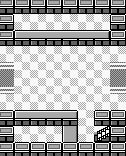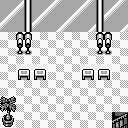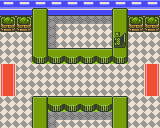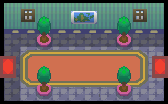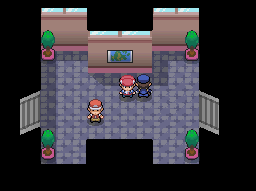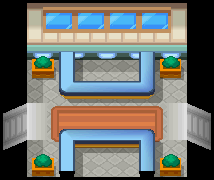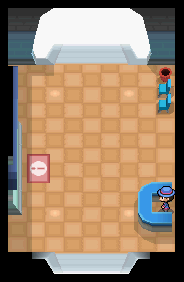Gate: Difference between revisions
m (→List of gates) |
m (→List of gates) |
||
| Line 211: | Line 211: | ||
| [[Skyarrow Bridge]] || [[Castelia City]] || [[Unova]] || Called '''Bridge Gate''' in the game. It is the only Bridge Gate in the game directly bordering a city. | | [[Skyarrow Bridge]] || [[Castelia City]] || [[Unova]] || Called '''Bridge Gate''' in the game. It is the only Bridge Gate in the game directly bordering a city. | ||
|- | |- | ||
| {{rt|4|Unova}} || [[Castelia City]] || [[Unova]] || Called '''Castelia Gate''' in the game. | | {{rt|4|Unova}} || [[Castelia City]] || [[Unova]] || Called '''Castelia Gate''' in the game. In {{2v2|Black|White|2}}, [[Bianca]] will give {{player}} the [[Dowsing MCHN]]. | ||
|- | |- | ||
| {{rt|4|Unova}} || [[Nimbasa City]] || [[Unova]] || [[Professor Juniper]] will give ten {{ball|Ultra}}s to the player and another ten to [[Cheren]] in this gate. Called '''Nimbasa Gate''' in the game. | | {{rt|4|Unova}} || [[Nimbasa City]] || [[Unova]] || [[Professor Juniper]] will give ten {{ball|Ultra}}s to the player and another ten to [[Cheren]] in this gate. Called '''Nimbasa Gate''' in the game. | ||
Revision as of 10:59, 27 June 2012
Gates (Japanese: ゲート gate) are prominent features of routes in the Pokémon world. They are located at junctions between different routes, or placed between a route and a city.
In the games
Generation I
In Generation I, gates serve to separate two areas, and also to guard the corresponding route, which is why an Officer usually resides inside. Upon speaking to the Officer, they may offer words of advice or information about the route or city that the gate guards.
Certain gates contain a second floor that features a spot where binoculars can be used to see faraway landmarks, or even certain Pokémon. In some of these, the player will usually encounter one of Professor Oak's aides. He will check the Pokédex and will reward the player if he or she has caught a given number.
There are also certain gates the player is forbidden to enter until the Officer, who claims to be thirsty, is given a drink that can be bought at the Celadon Department Store. These gates are those found on Routes 5, 6, 7 and 8 and all lead to Saffron City.
| The exterior of any gate in Generation I |
The interior of a regular gate in Generation I | The ground floor of a two-story gate in Generation I | The second floor of a two-story gate in Generation I |
Generation II
Much like Generation I, gates serve to separate two areas. Unlike other buildings, the player can often ride their bicycle through these buildings to guarantee fast transportation.
At the gate leading to Route 35, to the north of Goldenrod City, is Randy, a non-player character, who will give a Spearow to the player that holds Mail to be delivered to his friend on Route 31.
| The exterior of any gate in Generation II |
The interior of any gate in Generation II |
Generation III
Gates are sparse in the Hoenn-based Generation III games. There are only two gates, each connected to the Seaside Cycling Road. Players may not ride bicycles as they travel away from the Cycling Road, but are forced upon their bicycle if traveling toward it. If the bicycle has not been obtained, they may not enter.
In FireRed and LeafGreen, gates serve the same purpose as in Generation I. The only significant change is that since players can now trade items attached to a Pokémon, the key item Tea was introduced to prevent the player from advancing through the gates surrounding Saffron City prematurely. This key item serves the same purpose as the drink from the original games. Gates exist also in the Sevii Islands, giving access from the port to each town.
| Picture | Description |
|---|---|

|
The exterior of the gates at Seaside Cycling Road in Ruby, Sapphire and Emerald. |
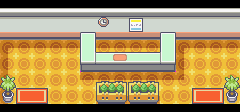
|
The interior of the gates at Seaside Cycling Road in Ruby, Sapphire and Emerald. |

|
The exterior of any gate in Kanto in FireRed and LeafGreen. |
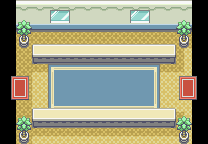
|
The interior of a regular gate in Kanto in FireRed and LeafGreen. |
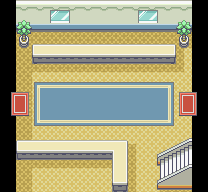
|
The ground floor of a two-story gate in Kanto in FireRed and LeafGreen. |
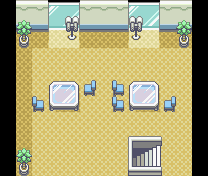
|
The second floor of a two-story gate in Kanto in FireRed and LeafGreen. |

|
The exterior of the gates at the Sevii Islands, Navel Rock and Birth Island in FireRed and LeafGreen. |
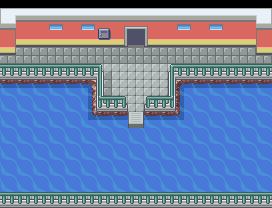
|
The interior of the gates at the Sevii Islands, Navel Rock and Birth Island in FireRed and LeafGreen. |

|
The exterior of the gates in Navel Rock and Birth Island in Emerald. |
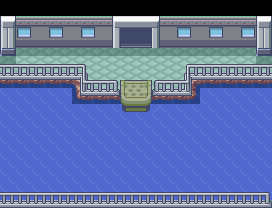
|
The interior of the gates in Navel Rock and Birth Island in Emerald. |
Generation IV
Much like in past generations, the gates in Generation IV serve to separate two areas. In Diamond and Pearl, the player cannot ride their bicycle through these buildings, but this limitation was lifted in Platinum and HeartGold and SoulSilver.
In the Sinnoh-based games, Officers do not watch over the route, but other travelers can be found inside, as well as a map showing the player's current location.
In HeartGold and SoulSilver, the gates are similar to those in Generation II and the Officers in charge of guarding them are reinstated.
| The interior of any gate in Diamond and Pearl |
Lucas, an officer, and a Fisherman inside a gate in Platinum |
The interior of any gate in HeartGold and SoulSilver |
Generation V
| Hilbert inside a gate in Black and White | Kyouhei inside a gate in Black 2 and White 2 |
There are gates on several routes in Unova, each with a receptionist assigned to the gate. Unlike in previous games, each gate has an electric bulletin board and a screen on one of its walls. The bulletin board displays the current date, the weather in a few adjacent routes and towns (including what location a windstorm or thunderstorm is brewing at), information about a nearby town or city, and information about where Pokémon are swarming (once the player has obtained the National Pokédex). The screen shows images from the connected location. Also in these gates are a trash can and two chairs for a quick rest.
There are also some gates that only connect bridges that have unique designs, though these gates don't have bulletin boards and monitors. Unlike previous generations, where gates share their music with that of a near route, all the gates now share a new background music and each gate has a name (although the same name may be shared by multiple gates) that can be viewed when saving inside one or hatching an Egg there.
Practical use
The gates also have a practical use within the games' programming. As a player moves from a route to a town or city, the map's textures (tilesets in the first three generations) must be loaded for each. While this is easy when a city connects to relatively few routes, where all can use the same tileset/texture, areas like Saffron City and Jubilife City, which connect to many different areas, would need to load multiple tilesets/textures, potentially slowing down the game or even crashing it. The programmers, realizing this, broke up the overworld with these gates to assure crash-free gameplay, and to properly display the routes, towns and cities.
In the Generation IV games, a player can use a Walk Through Walls cheat to go from location to location without going through the gates. By doing this, the map textures work as expected, except for many of them appearing as white tiles. Some buildings seem to be invisible as well. The cheat can also be used in the Generation V games; however, the texture problem is very limited, if not completely absent.
List of gates
| ||||||||||||||||||||||||||||||||||||||||||||||||||||||||||||||||||||||||||||||||||||||||||||||||||||||||||||||||||||||||||||||||||||||||||||||||||||||||||||||||||||||||||||||||||||||||||||||||||||||||||||||||||||||||||||||||||||||||||||||||
Trivia
- Despite having been a mechanic of the games since Generation I, these buildings as a whole did not have an official name until Generation V. "Guardhouse" and "gatehouse" were popular fanon terms to refer to these buildings when they had no official name.


